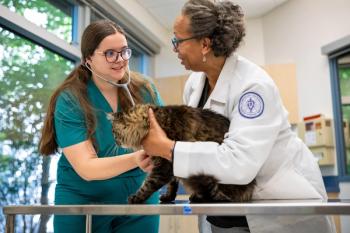
Physical rehabilitation techniques for hospice and palliative care patients (Proceedings)
A 5-step Hospice care plan was developed by Dr. Tami Shearer to act a template so no part of pet's care would get overlooked.
A 5-step Hospice care plan was developed by Dr. Tami Shearer to act a template so no part of pet's care would get overlooked. In review, the 5- Step Hospice Plan includes the following:
1. Evaluation of the pet owner's needs, beliefs, and goals for the pet.
2. Education about the disease process.
3. Development of a personalized plan for the pet and pet owner.
4. Application of hospice or palliative care techniques.
5. Emotional support during the care process and after the death of the pet.
In step 3, a personalized plan should be developed for the pet and pet owner. There are many rehabilitation techniques that can benefit a pet that needs palliative care or a pet that is terminally ill. Rehabilitation techniques can help these pets in a variety of ways. It may result in relief or decrease of pain, decrease in muscle tension, decrease in scar tissue, improvement in circulation, improvement in range of motion, return the pet to function and performance, speed the recovery time from injury, prevent surgery, maintain muscle strength, and improve emotional and physical quality of life.
Different physical modalities include using manual therapies like massage, range of motion, and stretching. Thermal therapies include ice and heat. Other methods to achieve improvement or maintaining quality of life are low-level therapy laser, hydrotherapy, therapeutic ultrasound, estim, and acupuncture. All modalities are non-invasive and have little risk associated with them when applied properly. It is recommended that professionals that have a special interest in these therapies receive advanced training to insure proper application.
Many clinical conditions may benefit from physical rehabilitation. Therapy should be considered but not limited to the following; post-operative pain, osteoarthritis, neurological dysfunction, orthopedic injury, soft tissue injury, weight management, decreased mobility, weakness, chronic illness, and debilitation.
Massage may help decrease pain and improve circulation. Simple techniques such as assisted standing by the use of slings or a towel help to slow muscle atrophy. Weight shifting may help a pet stay mobile with less loss of balance. Utilizing exercise balls make supporting a pet's weight easier and may also promote range of motion or stretching at the same time. Range of motion exercises may decrease pain while improving mobility and strength.
Adjusting the position of the pet may prevent decubital ulcers and pressure sores as well as atelectesis and lung congestion. Respiratory secretions may be managed with manual therapy of percussion, vibration, postural drainage, and initiating a cough by palpating the trachea. This should not be attempted if there has been thoracic trauma, a low platelet count, sub-cutaneous emphysema, or a heart condition.
Heat therapy in the form of warm moist heat helps decrease pain or muscle spasm, improves circulation, and if used immediately prior to stretching may increase flexibility/tissue extensibility. By placing a hand between the heat source and pet, one can avoid overheating. Cryotherapy in the form of ice may help to naturally reduce inflammation. These modalities should be avoided if a pet is experiencing decreased sensation or is unable to give feedback. Obese pets may be prone to overheating. Vascular disease could also put the pet at risk. Cold and heat should not be used over malignant neoplasia and over areas of acute inflammation or infection.
Electrical stimulation is a general term for a therapy that uses mild electrical impulses to regain muscle strength, re-educate muscles, control pain, and reduce edema. Human studies show it may also have antiemtic effects. Two types of applications are commonly used to help pets: transcutaneous electrical stimulation, also known as TENS, and neuromuscular electrical stimulation, or NMES. TENS is used for pain control in pets.
NMES is the application of an electrical current placed on the skin in order to elicit a muscle contraction. It is used for muscle reeducation and strengthening but may also aid in improving function by improving range of motion. NMES may also help slow or prevent muscle atrophy. Contraindications of electrical stimulation include using it on pets with seizure disorders. It should not be used over dermatitis, neoplasia, and in peripheral vascular disease. Never use it over the heart, over thrombophlebitis, or over pace makers.
Aquatic therapy is a useful tool for dogs and some cats. Aquatic therapy uses warm water to assist in exercise for pets that have trouble bearing weight due to pain, weakness, or because of loss of balance. Aquatic therapy can be used in pets with osteoarthritis, muscle weakness, neurological disorders, and muscle pain.
Aquatic therapy contraindications include heart conditions, respiratory disorders, vascular disease, dermal infections, and diarrhea.
Low-level lasers are used in rehabilitation to treat a number of conditions. Unlike surgical lasers, therapy lasers work at the cellular level to affect tissue response without the heating or cutting of tissues. Studies show that lasers may decrease muscle spasms and pain, improve circulation in the muscles, and increase extensibility of collagen. Some positive effects have been seen in nerve regeneration studies.
Therapeutic ultrasound can be used in pets to increase the rate of wound healing, decrease muscle spasms and pain, and improve circulation in the muscles. It also increases extensibility of collagen. Care and training in administration of therapeutic ultrasound is important to avoid discomfort and serious complications such as overheating of the periosteum and to understand its other contraindications.
Another physical intervention that should be considered for pets includes acupuncture which may aid the treatment of pain, paresis, and paralysis, wound healing and other disease processes.
In addition to the physical benefits, many pets are behaviorally stimulated by the interaction associated with the application of rehabilitation modalities. Rehabilitation techniques should be incorporated in all conditions where the pets could benefit.
Newsletter
From exam room tips to practice management insights, get trusted veterinary news delivered straight to your inbox—subscribe to dvm360.





